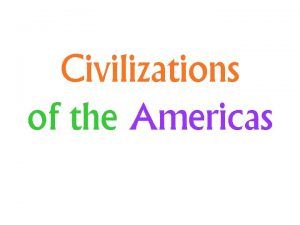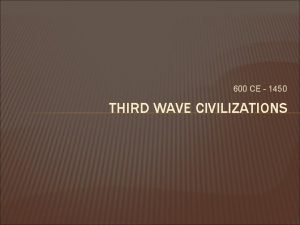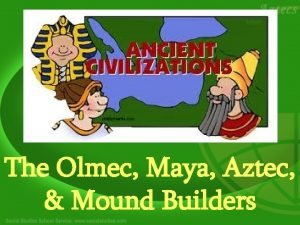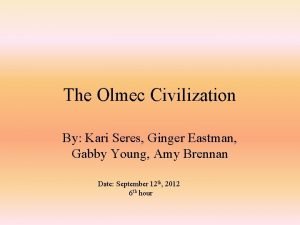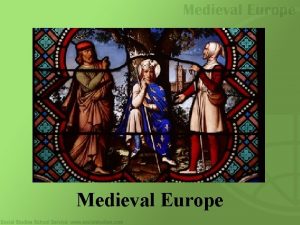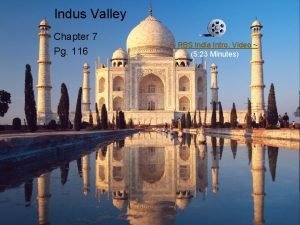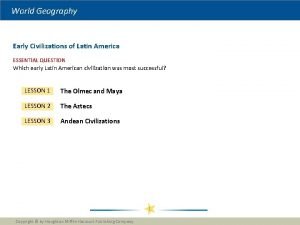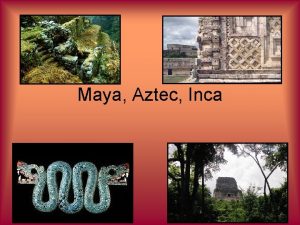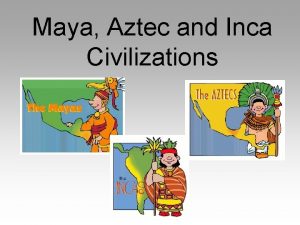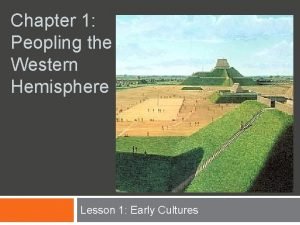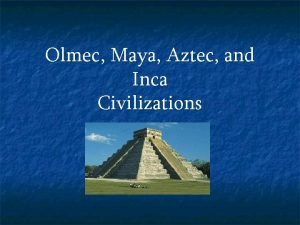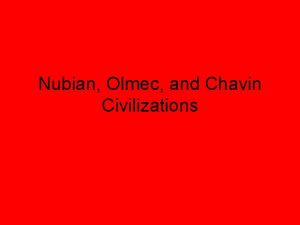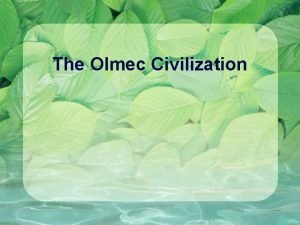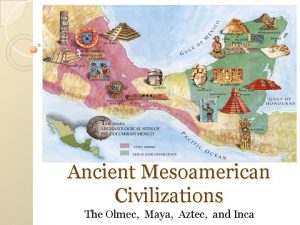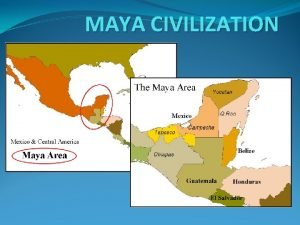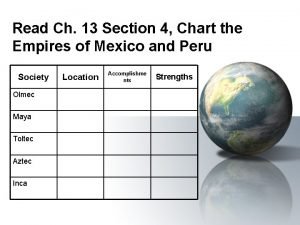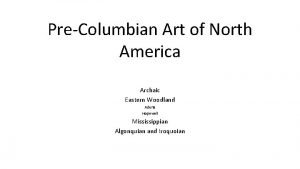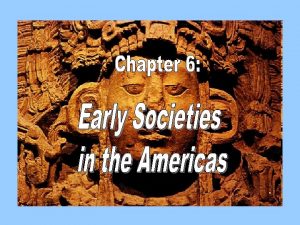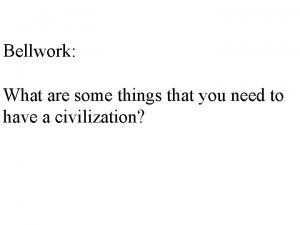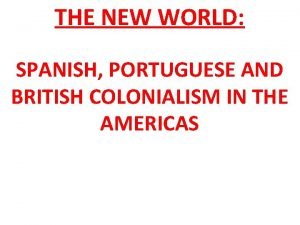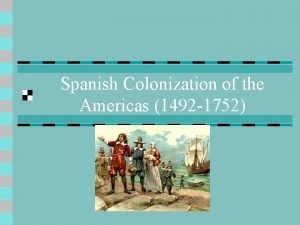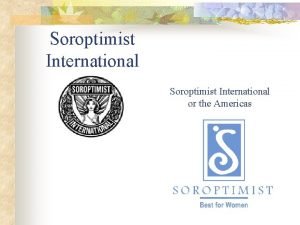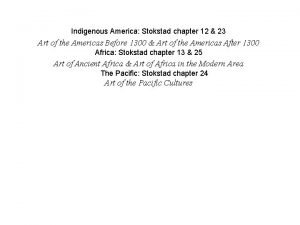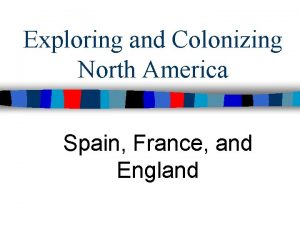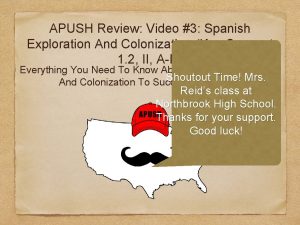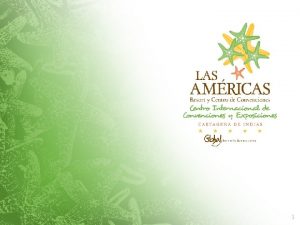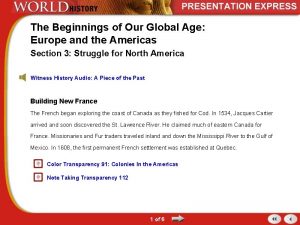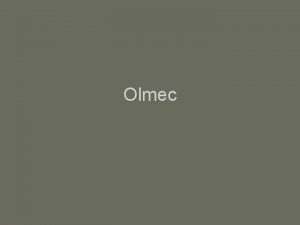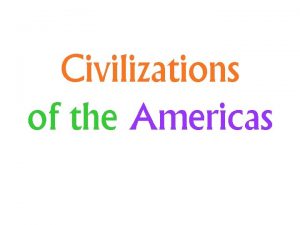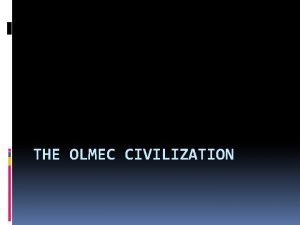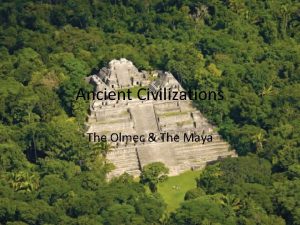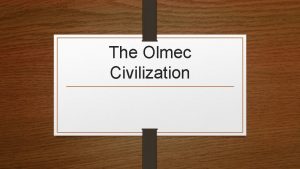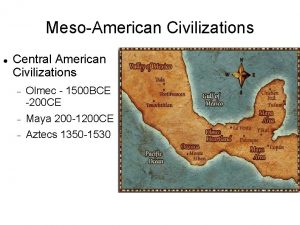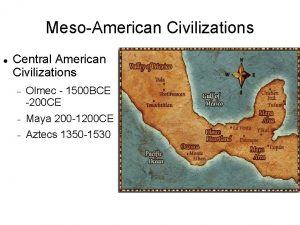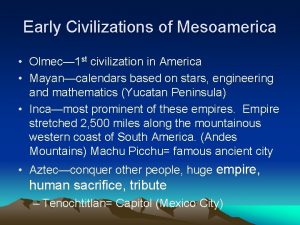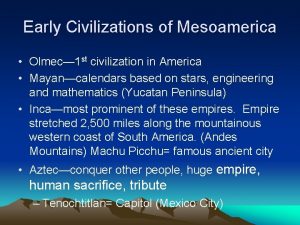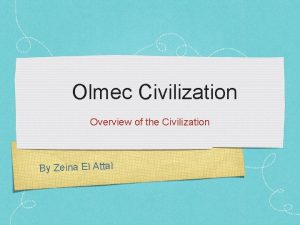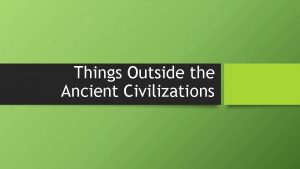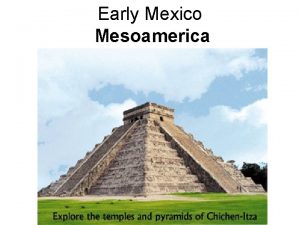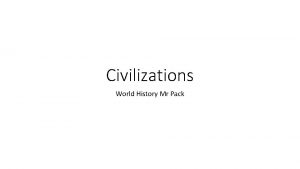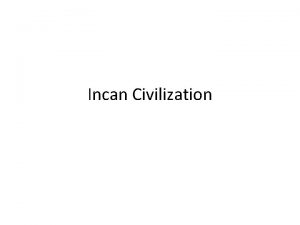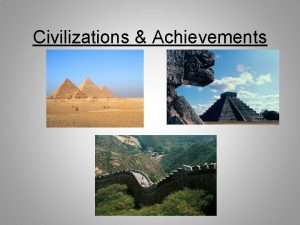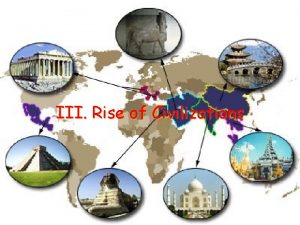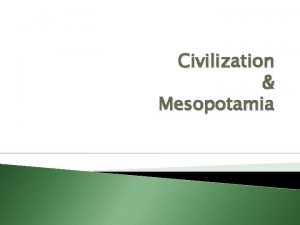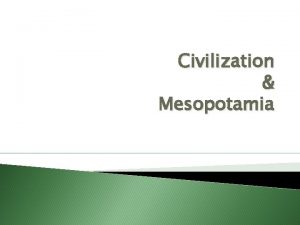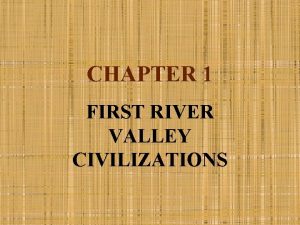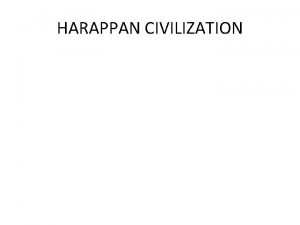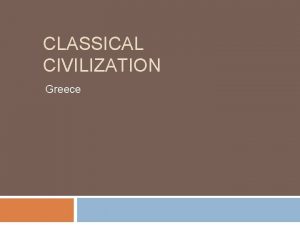Civilizations of the Americas Olmec Civilization Time Period













































- Slides: 45

Civilizations of the Americas

Olmec Civilization Time Period Arose between 1200 to 1000 BC Geography Originally from the gulf coast of southern Mexico but expanded into Guatemala Society An agricultural people There were two groups the elite group lived in small urban centers and the common people lived in rural areas

Olmec Civilization Origins 1400 -400 BCE --San Lorenzo Tenochtitlan, La Venta, Tres Zapotes, and Laguna de los Cerros are the Olmec heartland. --The Olmecs first appeared within the city of San Lorenzo Tenochtitlan. The civilization here was assisted by the local ecology of well-watered alluvial soil, as well as by the transportation network that the Coatzacoalcos river basin provided.

Maya Civilization Meso-America

Olmec Civilization Humanitas-international. org

Olmec Civilization Origins --La Venta is dated to between 1200 BCE through 400 BCE --Located on an island in a coastal swamp overlooking then-active Rio Palma river. --Lasted from 900 BCE until its abandonment around 400 BCE. Decline --Between 400 and 350 BCE, population in the eastern half of the Olmec heartland dropped precipitously. --volcanism instead of extinction.

Olmec Civilization Olmec Basalt Heads --First Olmec head found at Tres Zapotes --Stone heads measured eight to nine feet in height and weighing 20 -40 tons --Carved from stone obtained 50 miles or more from the site. --Works were somehow floated via waterways to La Venta, located on an island near the Gulf Coast --A number of massive stone altars and stelae, were found at La Venta, the culture's most important center. Ocf. berkeley. edu

Toltec Civilization --They have their beginnings in northern Mexico near Tula --They were a war-like people and expanded rapidly throughout Mexico, Guatemala and the Yucatan peninsula. --The name Toltec is derived from the word Toltecatl which means craftsman in Nahua. --They expanded the cult of Quetzalcoatl the Sovereign Plumed Serpent. It was believed that Quetzalcoatl was the creator of humanity. He was a warrior god who had been driven from Tula but would return one day. --They conquered Maya controlled areas such as Chichen Itza.

Mayan Civilization Maya Rise and Fall http: //ngm. nationalgeographic. com/2007/08/maya-rise-fall/map-interactive

Mayan Civilization Maya Rise and Fall http: //www. youtube. com/watch? v=d. OWqg. Qsric. A

Meso. America http: //www. crystalinks. com/olmec. html

Mayan Civilization Classical Period (300 -900 AD) Yucatan Peninsula Learner. org

Mayan Civilization Periodization Early Classical (292 -593) Late Classical Period (593 -889) Geography Yucatan Peninsula (Mexico) and Guatemala Tikal— Chichen Itza Uxmal (Ooshmal) Copan—northern Honduras

Mayan Civilization Agricultural Method Slash and Burn Milpa, as it was known by the Mayans 1. Trees were cut down 2. The downed trees were burned for fertilizer 3. The plot of land was cultivated

Mayan Civilization Slash and Burn Main Crops of the Mayans included: Maize Beans Peppers and Tomatoes

Mayan Civilization Up in Smoke: The Perils of Slash and Burn Agriculture http: //www. pbs. org/newshour/bb/environment/janjune 11/slashandburn_06 -09. html

Mayan Civilization Religion Agriculture Their religion and agriculture were thoroughly intertwined. Why? They needed accurate predictions of time to accommodate the cycles of life in the rain forest.

Mayan Civilization Timekeeping and the Mayan Calendar The Mayans were some of the most accurate reckoners of time. They used a number of calendars: Tzolkin—the sacred calendar, which consisted of 260 days. This calendar worked on two cycles, 13 numbered days and 20 named days. Tun—their ceremonial calendar which was 360 days long plus five unlucky days. Katun—had a cycle of 20 tuns Venus—had 584 days and determined the cycles of the sky gods.

Mayan Civilization Timekeeping and the Mayan Calendar December 21, 2012 http: //www. youtube. com/watch? v=Lt. TSnchr. K 3 M Extraordinary claims require extraordinary evidence --Carl Sagan

Mayan Civilization Society Halach Uinic (True Man) His position was hereditary. He ruled both domestic and foreign affairs with the help of a council. Beneath him were priests, commoners and slaves.

Mayan Civilization Religion Ah Kin Mai (The Highest One of the Sun) He ruled over all the priests below him called Ah Kin (The One of the Sun). Human sacrifice was common and the gods required nourishment from human beings in order to work. The majority of human sacrifice was blood-letting. The priest was usually a victim and gave pieces or parts of their bodies. Some ceremonies demanded a living heart of a victim. The chacs, an elderly priest held down the victim and the nacon made an incision below the rib cage and ripped out the victims heart.

Mayan Civilization Caracol, a Mayan archaeological site in Belize. Carocal was a crucial population center during the Classic Maya period. (Photo: Douglass Kennett/Penn State) MNN. com

Mayan Civilization Temple in the Kingdom of Tikal, one of the most prominent of the Classical Period CREDIT: © Science/AAAS Livescience. com MNN. com

Mayan Civilization Decline and Collapse MNN. com It was a prolonged process some causes are either social or environmental: Polygamy—spawning numerous lineages that warred against each other, overall generating conditions ripe for collapse. Tribute—funneled wealth to a small ruling elite topped by hereditary divine kings, who had virtually unlimited power but whose subjects expected generosity. Drought and deforestation—Deforestation linked with farming could also have triggered disaster— for instance, reduced tree cover of the ground would have led to loss of fertile topsoil by erosion, as well as greater evaporation of water by sunlight, exacerbating drought. http: //www. livescience. com/19211 -mayan-collapse-belief-gods. html

Aztec Civilization Origins MNN. com The Aztec culture was influenced by a tribe of the Mexica (meshee-ka) called the Tenochca (te-noch-ka). The Mexica migrated from the north into the valley of Mexico early as the 12 th century AD. They were part of the Chichimec (wild people) who settled Mesoamerica from the north but became Toltec (craftspeople) proper. Chichimec Mexica (Tenochca) Toltec Aztec

Aztec Civilization Lake Texcoco Their god Huitzilopochtli commanded them on a journey to the south. They arrived in the valley of Mexico in 1248. They moved because they became vassals of the town of Culhuacan. Some settled on an island in the middle of the lake between 1300 and 1375. It eventually became known as Tenochtitlan or place of the Tenochcas. They settled there when they saw an eagle perched on top of a cactus. Weber. ucsd. edu

Aztec Civilization MNN. com Tenochtitlan (The Impossible City) http: //www. youtube. com/watch? v=_n. S 6 Mp. Vb. B_g

Aztec Civilization Mexicolore. co. uk Itzcoatl (r. 1428 -1440) 4 th ruler of the Aztec Empire Obsidian Serpent He helped to build temples, roads and a causeway linking the city to the mainland. Tenochtitlan was a major urban center with a bustling market.

Aztec Civilization Agricultural Method MNN. com Chinampa Method Flat reeds were placed in the shallow areas of the lake and covered with soil and cultivated.

Aztec Civilization Chinampa Method MNN. com Anthropogen. com

Aztec Civilization Chinampa Method MNN. com http: //www. youtube. com/watch? v=z. ANQy_gj. C 0 I

Aztec Civilization Social Structure MNN. com Nobility (Pilli)—One could rise to this position by having a skill or bravery in battle. Commoners—Macehualles Kinship Groups (Calpulli)—They were found mostly in the city and were known for craft-making. Slaves—Someone could be a slave by being captured in war, committing crime or being sold by parents.

Aztec Civilization Religion MNN. com Tlacatecuhtli (Chief of Men) Dominated all religious ceremonies and served as military leader

Aztec Civilization Class. uh. edu Huitzilopochtli Hummingbird Wizard War and Sun god

Aztec Civilization Tezcatlipoca Smoking Mirror Chief god of the Aztecs Class. uh. edu

Aztec Civilization Quetzalcoatl Sovereign Plumed Serpent God of civilization, the priesthood and learning Class. uh. edu

Inca Civilization Land of the Four Quarters or Tahuantinsuyu is the name the Inca gave to their empire. It stretched north to south some 2, 500 miles along the high mountainous Andean range from Colombia to Chile and reached west to east from the dry coastal desert called Atacama to the steamy Amazonian rain forest. http: //www. pbs. org/wgbh/nova/ancient/lost-inca-empire. html

Inca Civilization Inti—god of sun, enabled life and was widely worshipped by farmers. Viraccocha—god of civilization the sun was revered for enabling life and was most widely worshipped by the farmers, whose harvests lay in the balance between a helpful or destructive sun. Incas, a confederation of tribes ruled by a council of elders. The Sapas Inca was the divine representative of the Sun god.

Inca Civilization Social Structure Inca Tribes Clans Common People Latinamericanstudies. org

Inca Civilization Language Quechua Oral language Quipu Color coded knotted cords Uncp. edu

Inca Civilization Agricultural Method Terrace Farming The Inca dug terraces on mountains sides and used it to farm. Stones would gather heat throughout the day and during the night would distribute the heat to the plants. These structures were helpful for other reasons too. Because they had stone around them, erosion was virtually impossible. The irrigation system caught water coming down the mountain and then distributed water to each plant. http: //incakjew. weebly. com/terracefarming. html Penfield. edu

Inca Civilization Machu. Picchu. org

Inca Civilization Intihuatana Stone The Hitching post of the Sun Sacredsites. com

Inca Civilization Michael Palin in Machu Picchu—BBC http: //www. youtube. com/watch? v=P 2 YBVlgqqco

Inca Civilization Cuzco Peru: Clear Evidence Of Great Builders Before the Incas http: //www. youtube. com/watch? v=66 x 9 VLw. Za. DQ
 Olmec civilization
Olmec civilization Third wave civilizations time period
Third wave civilizations time period Olmec daily life
Olmec daily life Olmec map
Olmec map Civilization time period
Civilization time period Vedic caste system
Vedic caste system Geography/environment of olmec
Geography/environment of olmec Inca vs maya
Inca vs maya Aztec inca maya timeline
Aztec inca maya timeline Olmec
Olmec Difference between aztecs and mayans
Difference between aztecs and mayans Olmec and chavin
Olmec and chavin Olmec bloodletting
Olmec bloodletting Mesoamerican civilizations timeline
Mesoamerican civilizations timeline Olmec south america
Olmec south america Maya timeline
Maya timeline Olmec sheffield
Olmec sheffield The olmec
The olmec Olmec
Olmec Was the olmec empire polytheistic or monotheistic
Was the olmec empire polytheistic or monotheistic Start time, end time and elapsed time
Start time, end time and elapsed time The development of children 7th edition
The development of children 7th edition A&p flix activity: generation of an action potential
A&p flix activity: generation of an action potential Is hyperpolarization the same as refractory period
Is hyperpolarization the same as refractory period Critical period vs sensitive period
Critical period vs sensitive period Critical period vs sensitive period
Critical period vs sensitive period Critical period vs sensitive period
Critical period vs sensitive period This period lasted from approximately 1775 - 1825
This period lasted from approximately 1775 - 1825 Transition element period 5 51 neutrons
Transition element period 5 51 neutrons Period of activism year
Period of activism year Stability period vs measurement period
Stability period vs measurement period Trustee period and royal period
Trustee period and royal period Bc va ad
Bc va ad Spanish caste system in the americas
Spanish caste system in the americas Spanish colonization of the americas
Spanish colonization of the americas Soroptimist international of the americas
Soroptimist international of the americas Art of the americas before 1300
Art of the americas before 1300 Ib history exam
Ib history exam English territories in france
English territories in france Declaración sobre seguridad en las américas 2003
Declaración sobre seguridad en las américas 2003 Spanish caste system in the americas
Spanish caste system in the americas Americas guardians mc
Americas guardians mc Centro internacional de convenciones
Centro internacional de convenciones The beginning of our global age europe and the americas
The beginning of our global age europe and the americas Transversal de las americas
Transversal de las americas Openedge multi-tenant cloud
Openedge multi-tenant cloud
